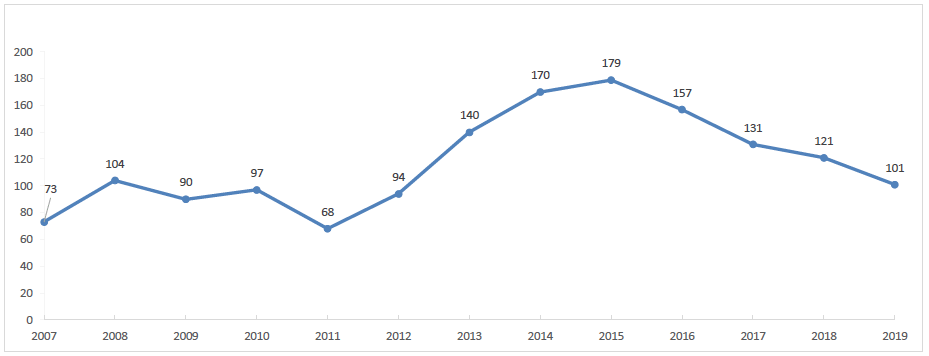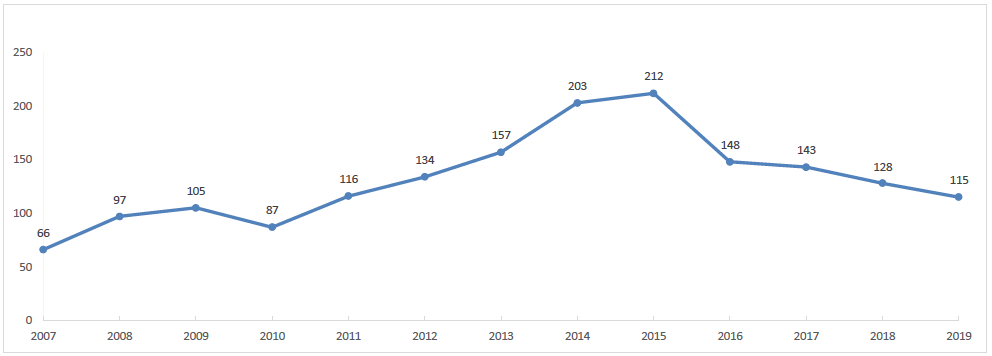Fireworks regulations - impact: case studies
This paper consists of seven case studies, each one aligned to one or more of the legislative options being considered by the Firework Review Group.
Annex A - Additional Tables and Graphs
As mentioned in the main body, with the exception of the Northern Territory and Tasmania, consumer fireworks are prohibited in all states and territories in Australia.
| State/Territory | When public use of fireworks banned | Aligned legislative option |
|---|---|---|
| Australian Capital Territory | 2009 | A |
| New South Wales | 1987 | |
| Queensland | 1972 | |
| South Australia | 2001 | |
| Victoria | 1985 | |
| Western Australia | 1967 |
New South Wales
No relevant evidence from New South Wales could be sourced for this paper.
South Australia
The fireworks industry in South Australia is relatively small, with around 50 current licensed pyrotechnicians. According to SafeWork South Australia (the regulator), the introduction of firework regulations significantly reduced the number of fireworks complaints[78].
Data provided by the South Australia Police shows that since 2014 the number of offences for fireworks possession has been negligible.
|
|
2014 | 2015 | 2016 | 2017 | 2018 | 2019 | 2020 |
|---|---|---|---|---|---|---|---|
| Possess firework other than general use* | 5 | 4 | 5 | 2 | 6 | 5 | 3 |
Source: South Australia Police
*General use firework means- toy pistol caps; starting pistol caps; sparklers; party poppers; bonbon crackers or snaps for bonbon crackers; blaster balls; aluminium torches, amerces, indoor table bombs or magnesium torches.
Queensland
Graph A shows the number of patients admitted to public and private acute hospitals in Queensland due to an injury caused the by discharge of a firework. Since a high of 25 in 1999/00, the number of admitted patients has been small each year (< 15). Across the time series, a total of 209 people were admitted to hospital. Corresponding data for those presenting at emergency departments could not be provided by the Department of Health.

Source: Department of Health, Queensland.
In Queensland there is a two-tier licensing system: contractors and operators, with the former holding the most responsibility. The licensing system was altered following the death of an 11 year old girl at a public fireworks display in 2000. The subsequent coroner's investigation of the state of fireworks regulation and usage resulted in 17 recommendations for change, the most significant of which concerned the licensing system.
At the time of writing, there are 25[79] active fireworks contractors in the state. The fireworks contractor licence authorises the holder to:
1. organise a fireworks display (must notify the Explosives Inspectorate)
2. possess fireworks
3. purchase fireworks
4. supply fireworks to a fireworks operator for use in an organised fireworks display
5. store and transport fireworks
Contractors employ fireworks operators to conduct displays, and they may also be operators themselves. At the time of writing, there are 164 licenced firework operators in Queensland. The fireworks operator's licence authorises the holder to:
1. use fireworks for the purpose of a fireworks display
2. possess fireworks for the purpose of using them in a fireworks display
3. store and transport fireworks for the purpose of using them in a fireworks display
In the lead up to the millennium celebrations there was a significant increase in the number of licenced people. The original 600 operators across the state doubled and approximately 2,600 displays were conducted in 2000. By restricting the number of licenced persons the number of displays fell[80]. The number of firework display notifications received by the Queensland Inspectorate from 2007 to 2019 is shown in Graph B. From the data we can see an increasing trend in the number of displays from 2012 to 2018. The number of notifications dipped in 2019 to 1,471, similar to the figures for 2013. This decrease has been attributed to the bushfires experienced in Queensland in 2019.

Source: Queensland Explosives Inspectorate
Table B details fireworks complaints[81] received by the Inspectorate from 2014 to 2019. It shows the number of complaints concerning displays that were not notified to the Inspectorate- illegal in Queensland. It also details the total number[82] of complaints received. There has been an increase in the total number of complaints and the number of complaints concerning displays without notification. However, anecdotal information indicates that this is constitutes a small fraction of the amount of illegal fireworks use in Queensland[83]. The Inspectorate attributes some of the increase in complaints to the rise of social media as well as the introduction of a dedicated fireworks complaints form on the Department's website.
| 2014 | 2015 | 2016 | 2017 | 2018 | 2019 | |
|---|---|---|---|---|---|---|
| Number of displays without Inspectorate notification | 9 | 14 | 19 | 33 | 36 | 41 |
| Total fireworks complaints | 44 | 44 | 54 | 70 | 76 | 111 |
Source: Queensland Explosives Inspectorate
The Explosives Inspectorate provides a 'recovery' service for fireworks. This includes when members of the public request the removal of fireworks, fireworks are handed in and when fireworks are seized by police. Graph C shows the number recovery operations (when an Inspector has been deployed to recover fireworks) from 2015 to 2019. Recovery operations increased from 2012 to 2015 before decreasing in the past four years, with the number in 2019 (101) similar to that in 2008 (104). Recent emphasis on reducing the traffic of illegal fireworks into Queensland from other states and territories may at least in part account for some of the decrease in the number of fireworks recoveries in the recent years. During operations the quantities of fireworks recovered varied from a single 'cracker' to approximately 500 kg[84].

Source: Queensland Explosives Inspectorate
Queensland Police provided figures on the number of calls for service received in relation to firework incidents from 2014 to 2019. Table C shows that following a sizeable decline in 2015 the number has increased every year since, although the changes have been small.
| 2014 | 2015 | 2016 | 2017 | 2018 | 2019 | |
|---|---|---|---|---|---|---|
| Calls for service | 1,448 | 1,149 | 1,338 | 1,410 | 1,481 | 1,487 |
Source: Queensland Police Service
Queensland Police also shared information regarding the number of recorded firework offences from 2007 to 2019. From 2011 to 2015, the number of firework offences increased year-on-year, peaking at 212. There was a sharp fall in 2016 and since then the number has followed a declining trend. Notwithstanding this recent decrease, the number of firework offences in 2019 was 74% higher than in 2007.

Source: Queensland Police Service
Victoria
No relevant evidence from Victoria could be sourced for this paper.
Western Australia
The Western Australia Department of Mines, Industry Regulation and Safety believes that the licensing system works well- with the two tier system (separate licenses for contractors and operators) providing numerous layers of accountability[85]. The system has been in place for over 10 years and in spite of initial concerns from the industry, it is not a source of contention. The licensing system is not onerous or costly to run. About 200 fireworks displays are held each year in Western Australia.
Data provided by the Department of Fire and Emergency Services shows the number of fires started by fireworks each year from 2000 to 2019. From Table D we can see that there is no increasing or decreasing trend in the number of fires started by fireworks. Rather, the number has been largely constant, punctuated by a few spikes. Across the time series, most fires started by fireworks have been accidental.
| 2000 | 2001 | 2002 | 2003 | 2004 | 2005 | 2006 | 2007 | 2008 | 2009 | 2010 | 2011 | 2012 | 2013 | 2014 | 2015 | 2016 | 2017 | 2018 | 2019 | |
|---|---|---|---|---|---|---|---|---|---|---|---|---|---|---|---|---|---|---|---|---|
| Number of fires | 28 | 25 | 24 | 9 | 30 | 14 | 24 | 19 | 27 | 23 | 25 | 17 | 19 | 23 | 27 | 26 | 24 | 23 | 19 | 31 |
| Accidental | 16 | 8 | 9 | 3 | 14 | 6 | 18 | 9 | 10 | 15 | 13 | 12 | 7 | 11 | 14 | 15 | 11 | 14 | 12 | 17 |
| Deliberate | 7 | 6 | 6 | 2 | 3 | 2 | 1 | 3 | 6 | 3 | 7 | 2 | 5 | 7 | 6 | 6 | 4 | 2 | 3 | 5 |
| Suspicious | 5 | 8 | 8 | 3 | 10 | 4 | 5 | 5 | 9 | 5 | 5 | 3 | 5 | 4 | 7 | 5 | 8 | 6 | 4 | 9 |
Source: Operational Information Systems, Department of Fire and Emergency Services, Western Australia
Contact
Email: socialresearch@gov.scot
There is a problem
Thanks for your feedback